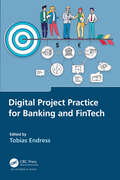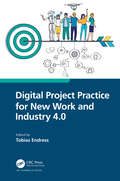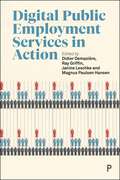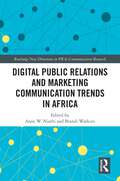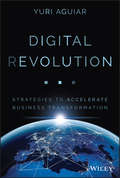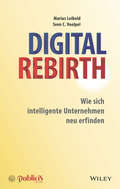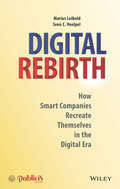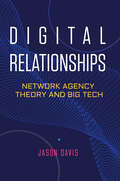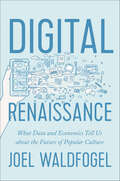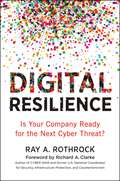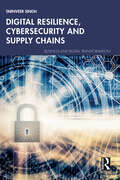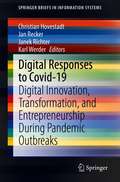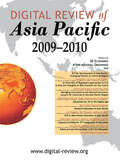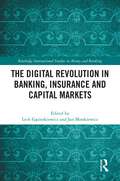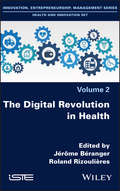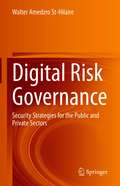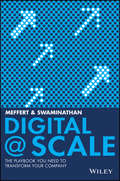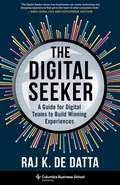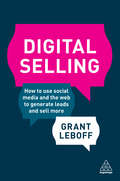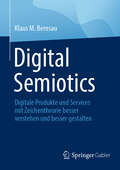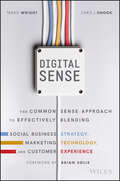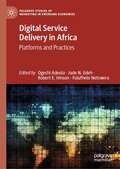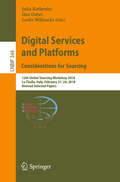- Table View
- List View
Digital Project Practice for Banking and FinTech
by Tobias EndressNew technology and changes in the regulatory framework have had a significant impact; various new players have emerged, and new business models have evolved. API-based ecosystems have become the new normal and collaboration in the financial and banking industry has reached new levels. Digital Project Practice for Banking and FinTech focuses on technology changes in the financial industry and their implications for business practice.A combination of practical experience in the field as well as academic research, the book explores a wide range of topics in the multifaceted landscape of FinTech. It examines the industry’s various dimensions, implications, and potential based on academic research and practice. From project management in the digital era to the regulation and supervision of FinTech companies, the book delves into distinct aspects of this dynamic field, offering valuable insights and practical knowledge. It provides an in-depth overview of various unfolding developments and how to deal with and benefit from them.The book begins by exploring the unique challenges and opportunities project management presents in the digital era. It examines the evolving role of project management and provides strategies for effectively navigating the complexities of digital transformation initiatives. The book then covers such topics as: Financial Technology Canvas, a powerful tool for facilitating effective communication within fintech teams Process automation implementation in the financial sector and related benefits, challenges, and best practices to drive operational efficiency and enhance customer experiences Robotic process automation in financial institutions Cyptoeconomics and its potential implications for the diffusion of payment technologies The efficiency and risk factors associated with digital disruption in the banking sector. At its core, this book is about real-world practice in the digital banking industry. It is a source of different perspectives and diverse experiences from the global financial and banking industry..
Digital Project Practice for New Work and Industry 4.0
by Tobias EndressNew Work and Industry 4.0 have matured and this book takes a practical, experience-based approach to project management in these areas. It introduces methods and covers the practical aspects. It critically examines existing approaches and practices and shows their limitations. The book covers appropriate methods as well as human and social aspects. It contributes to the ongoing discussion of business practices and methods. It also aims to stimulate dialogue in the professional community. Digital Project Practice for New Work and Industry 4.0 begins by introducing basic concepts in the context of Industry 4.0 and discussing how they might influence organizational communication and impact the work environment. After examining the possibilities and challenges of remote work and collaboration in distributed teams all over the world, the book looks at a company's fundamental changes related to New Work from a practical business perspective as well as legal and ethical perspectives. It reviews the case of the VW emission scandal and recommends ways to improve corporate culture. Legal issues include New Work and hybrid forms of collaboration as well as liability for automated decisions (i.e., the potential need for an ‘electronic person’). Other implications for the workplace include how: Industry 4.0 might influence the potential demand for "Digital Unions" Industry 4.0, and lean production, and their applications can change industrial practices Open Banking presents new approaches and new business models Work structures and systems can empower employees’ work self-management This book also looks at how New Work effects individual workers. It addresses digital stress, introduces strategies for coping with it, and discusses related topics. It also explores the benefits of meditation and the economics of mind, body, and spirit. In essence, this book cover appropriate methods along with human and social factors. It also covers practice, different perspectives, and various experiences from all around the globe. Contributing to the ongoing discussion on business practices and methods, this book will nourish and stimulate dialogue in the professional community.
Digital Public Employment Services in Action
by Didier Demazière, Ray Griffin, Janine Leschke and Magnus Paulsen HansenThis book offers a comprehensive exploration of the ongoing digital transformation of public employment services (PES) – the most radical remaking of the welfare state in a generation. As PES shift from analogue to fully digitised services, this volume bridges the gap between technology, policy and frontline service provision. It provides a well-rounded analysis of the practical opportunities and challenges posed by digital welfare, reconnecting and reconciling technical possibilities and political ambitions with what is socially necessary as welfare systems undergo radical change.
Digital Public Relations and Marketing Communication Trends in Africa (Routledge New Directions in PR & Communication Research)
by Brandi Watkins Anne W. NjathiThe uptake of digital media platforms necessitates the need to understand how digital cultures of consumers and brands are unfolding. Despite the increase in usage and adoption of the internet in Africa, there is limited information about digital marketing trends on the continent. This book is among the first to present an edited collection of chapters on digital and influencer marketing authored by many who are either from or have close ties to Africa.This book showcases digital marketing trends in Africa that are burgeoning at the same speed as the uptake of technology in the continent. With this in mind, the contributors seek to interrogate digital marketing trends in two stages: the status of digital marketing on the African continent, including cases from Nigeria, Egypt, Uganda and Kenya, and an analysis of the rise of influencer marketing, including cases from Nigeria and Uganda. This book will explore factors driving the increase in digital media platforms in Africa as well as an analysis of the implications of the growth in digital marketing, using various theoretical and methodological underpinnings to probe trends.Digital Public Relations and Marketing Communication Trends in Africa provides significant implications for marketing scholars and researchers and will be relevant to those looking to understand the opportunities and challenges ahead.
Digital Quality Management in Construction
by Paul MarsdenMuch has been written about Building Information Modelling (BIM) driving collaboration and innovation, but how will future quality managers and engineers develop digital capabilities in augmented and video realities, with business intelligence platforms, robots, new materials, artificial intelligence, blockchains, drones, laser scanning, data trusts, 3D printing and many other types of technological advances in construction? These emerging technologies are potential game changers that require new skills and processes. Digital Quality Management in Construction is the first ‘how to’ book on harnessing novel disruptive technology in construction quality management. The book takes a tour of the new technologies and relates them to the management of quality, but also sets out a road map to build on proven lean construction techniques and embed technologically based processes to raise quality professionals’ digital capabilities. With the mountain of data being generated, quality managers need to unlock its value to drive the quality of construction in the twenty-first century, and this book will help them do that and allow those working in construction Quality Management to survive and thrive, creating higher quality levels and less waste. This book is essential reading for quality managers, project managers and all professionals in the Architecture, Engineering and Construction industry (AEC). Students interested in new and disruptive technologies will also learn a great deal from reading this book, written by a professional quality manager with nearly thirty years’ experience in both the public and private sectors.
Digital (R)evolution: Strategies to Accelerate Business Transformation
by Yuri B. AguiarWhy digital transformation is necessary and how to develop and execute a successful digital transformation strategyEven though the term ‘Digital Transformation’ is prevalent throughout the current business landscape, various misunderstandings and misconceptions are often attached to it. Everyone agrees that digital transformation is essential for any enterprise, but few can define what it actually means to the modern business. Digital transformation does not specifically or exclusively define the consequences of digital technology. The term refers to the fact that technology, which happens to be digital, enables people to solve their traditional problems with digital solutions. It’s not to say that their problems could not be solved using the older methods, they simply prefer the new way. Digital (R)evolution: Strategies to Accelerate Business Transformation explains why digital transformation is necessary and provides a framework for executing an effective implementation strategy.Filing a significant gap in current knowledge, this timely book helps senior executives and technology leaders create practical strategies which, when correctly applied, lead to successful digital transformation. Author Yuri Aguiar, Chief Innovation and Transformation Officer at The Ogilvy Group, shares his real-world insights on developing new, digital-based business models and internal processes. Written in clear, straightforward language, this valuable guide: · Serves as a blueprint for successful digital transformation in any enterprise or organization · Addresses the strategy and governance requirements of businesses regardless of industry · Features in-depth, firsthand examples of various transformation strategies · Explains the factors than cause strategies to succeed or fail Digital (R)evolution: Strategies to Accelerate Business Transformation is a much-needed resource for C-suite executives, corporate board members, corporate attorneys, investors, and venture capitalists.
Digital Rebellion: The Birth of the Cyber Left
by Todd WolfsonDigital Rebellion examines the impact of new media and communication technologies on the spatial, strategic, and organizational fabric of social movements. Todd Wolfson begins with the rise of the Zapatistas in the mid-1990s, and how aspects of the movement--network organizational structure, participatory democratic governance, and the use of communication tools as a binding agent--became essential parts of Indymedia and all Cyber Left organizations. From there he uses oral interviews and other rich ethnographic data to chart the media-based think tanks and experiments that continued the Cyber Left's evolution through the Independent Media Center's birth around the 1999 WTO protests in Seattle. After examining the historical antecedents and rise of the global Indymedia network, Wolfson melds virtual and traditional ethnographic practice to explore the Cyber Left's cultural logic, mapping the social, spatial and communicative structure of the Indymedia network and detailing its operations on the local, national and global level. He also looks at the participatory democracy that governs global social movements and the ways the movement's twin ideologies, democracy and decentralization, have come into tension, and how what he calls the switchboard of struggle conducts stories of shared struggle from the hyper-local and dispersed worldwide. As Wolfson shows, understanding the intersection of Indymedia and the Global Social Justice Movement illuminates their foundational role in the Occupy struggle, Arab Spring uprising, and the other emergent movements that have in recent years re-energized radical politics.
Digital Rebirth: Wie sich intelligente Unternehmen neu erfinden
by Marius Leibold Sven C. VoelpelDie digitale Transformation wird in vielen Fällen nicht ausreichen, um die Herausforderungen der Zukunft zu bewältigen. Digital Rebirth ist mehr, es bedeutet eine Neukonzeption der Ziele, Leistungen, Kultur und Prozesse eines Unternehmens, inklusive der technologischen Plattform. Dieses Buch präsentiert praktische Rahmenbedingungen für den Digital Rebirth. Es richtet sich an etablierte große und mittlere Unternehmen, an deren Zulieferer und Dienstleister ebenso wie an jüngere Unternehmen und Startups. Und damit an Vorstände und Eigentümer, Führungskräfte, Unternehmensgründer und Consultants. - In jedem Kapitel beschreibt es bewährte Konzepte des Digital Rebirth, von der digitalen Neuausrichtung über digitale Plattformen und Ökosysteme bis zu Hinweisen, wie man von überkommenen Auffassungen zu neuartigen Denkweisen kommt und sich von unternehmerischem Ballast und alten Prozessen befreit. - Es zeigt deutlich, wie bekannte Unternehmen den Rebirth bereits gemeistert haben - oder gerade dabei sind, sich zu einem der Spielmacher der digitalen Wirtschaft zu entwickeln. - Darstellungen für Unternehmen und Branchen werden unterstützt durch Beschreibungen der Ansätze, Methoden und praktische Tools. - Der Inhalt des Buchs dient als Grundlage für Workshops, Management-Meetings sowie Führungskräfte-Brainstormings, wie sie von den Autoren bereits erfolgreich durchgeführt wurden. - Am Ende des Buchs wird der Ansatz des Digital Rebirth zu einem Set von fünf digitalen Treibern zusammengefasst, als Tools für eine zielgerichtete und erfolgreiche Unternehmensneuausrichtung. Das Konzept des Digital Rebirth zeigt deutlich, dass etablierte Business- und Wettbewerbsmodelle unter dem Aspekt des Internet der Dinge, künstlicher Intelligenz, Industrie 4.0 und cloudbasierten Diensten nicht mehr ausreichen, die digitale Welt abzubilden und zu verstehen. Inhalt Digital Rebirth. Weil Digitale Transformation und Roadmaps nicht ausreichend sind Was Digitalisierung wirklich bedeutet. Trends, Konsequenzen, Mythen Was Digitalisierung von uns verlangt. Neue Denkweisen, richtige Fragestellungen Das Kernkonzept des Digital Rebirth. Der Aufbau digitaler Unternehmensplattformen Horizontaler Digital Rebirth. Unternehmens-Ökosysteme gestalten und pflegen Vertikaler Digital Rebirth. Die Nutzung cloudbasierter Dienste Prozesse, Menschen, Qualifikationen. Die Fähigkeiten zum Digital Rebirth entwickeln Digital Leadership. Die Neuausrichtung von Unternehmen Das Werkzeug. Fünf Treiber für erfolgreichen Digital Rebirth Fazit. Digital Rebirth als entscheidender Impulsgeber für Unternehmen "Eine zeitgemäße Orientierungshilfe für Manager und Berater in praktisch jeder Branche." ? Prof. Dr. Thomas Bauer
Digital Rebirth: How Smart Companies Recreate Themselves in the Digital Era
by Marius Leibold Sven C. VoelpelDigital Rebirth transcends digital transformation. It involves a revolutionary reinventing of the purpose, nature and processes of a company, with accompanying digital business and technological platforms. This book presents a clear framework for practical digital rebirth of companies, contrasting it to prevalent "digital transformation" approaches. Aimed at large and medium-sized companies, as well as their subcontractors and service providers, but also at budding entrepreneurs, it should be read and used by company boards, executives, managers, startup leaders and business consultants.. - In every section of the book you will find proven concepts of Digital Rebirth, digital reinvention, collaborative digital practices, combinatorial technologies, digital platforms, digital ecosystems and pointers how to move from obsolete mindsets and left-over baggage to reinvented digitalization minds and processes. - It shows clearly how some major companies have digitally rebirthed themselves - or are in the process of it - to be or to become a leading player in the digital economy. - Company (and industry) illustrations are accompanied by descriptions of Digital Rebirth approaches, methodologies and practical tools. - The book's content is ideal for use in company workshops and executive sessions, as well as business leadership mindset sessions, and has been validated in such activities by the authors, including boards of highly renowned companies on all continents. - At the end of the book, the unique approach of Digital Rebirth is condensed into a framework of five digital drivers, to assist in the right activities for purposeful and successful company rebirth. The concept of Digital Rebirth shows clearly that, in the light of recent developments like Internet of Things, Artificial Intelligence, Industry 4.0 and Cloud-based Services, well-established traditional industry and competitive models are not any longer satisfactory to understanding and dealing with digital realities.
Digital Relationships: Network Agency Theory and Big Tech
by Jason DavisWhy do so many organizations fail to mobilize the social networks of employees to respond to disruptions, innovate, and change? In Digital Relationships, Jason Davis argues that individual and organizational interests about networking can come out of alignment such that the network ties that individuals form are organizationally sub-optimal for achieving their most ambitious goals. Developing a new perspective about networks and organizations, he explains through network agency theory how network problems emerge, the role of digital technology adoption by organizations in amplifying misalignment, and the capacity of managers and function of the executive to resolve agency problems and mitigate their impact. Drawing on over a decade of qualitative research in US, Asian, and European "big tech" companies and new analytical and computational modeling, this book offers new interpretations and solutions to the pathologies that emerge from organizationally detrimental networking behaviors and in the face of managerial interventions.
Digital Renaissance: What Data and Economics Tell Us about the Future of Popular Culture
by Joel WaldfogelHow digital technology is upending the traditional creative industries—and why that might be a good thingThe digital revolution poses a mortal threat to the major creative industries—music, publishing, television, and the movies. The ease with which digital files can be copied and distributed has unleashed a wave of piracy with disastrous effects on revenue. Cheap, easy self-publishing is eroding the position of these gatekeepers and guardians of culture. Does this revolution herald the collapse of culture, as some commentators claim? Far from it. In Digital Renaissance, Joel Waldfogel argues that digital technology is enabling a new golden age of popular culture, a veritable digital renaissance.By reducing the costs of production, distribution, and promotion, digital technology is democratizing access to the cultural marketplace. More books, songs, television shows, and movies are being produced than ever before. Nor does this mean a tidal wave of derivative, poorly produced kitsch; analyzing decades of production and sales data, as well as bestseller and best-of lists, Waldfogel finds that the new digital model is just as successful at producing high-quality, successful work as the old industry model, and in many cases more so. The vaunted gatekeeper role of the creative industries proves to have been largely mythical. The high costs of production have stifled creativity in industries that require ever-bigger blockbusters to cover the losses on ever-more-expensive failures.Are we drowning in a tide of cultural silt, or living in a golden age for culture? The answers in Digital Renaissance may surprise you.
Digital Resilience: Is Your Company Ready for the Next Cyber Threat?
by Ray RothrockDon’t let your company be the next grim headline . . . Cybercrime is on the rise — and businesses large and small are at risk. For management, the question is not if you will be targeted, but when. Are you prepared? Is your enterprise actively monitoring networks, taking steps to understand and contain attacks, enabling continued operation during an incident? Do you have a recovery plan ready? Few are prepared, explains cybersecurity expert Ray Rothrock, who lays bare tactics used by hackers, vulnerabilities lurking in networks, and strategies not just for surviving attacks, but thriving even while under assault. Fascinating and highly readable, Digital Resilience opens with the infamous 2013 Target attack, which compromised the credit card information of 40 million customers. In hindsight, the hack (like most today) was preventable. This book helps businesses: Understand the threats they face • Assess the resilience of their networks against attacks • Identify and address weaknesses • Respond to exploits swiftly and effectively Data theft. Downed servers. Malware. Even human error can trigger cyber events anytime from anywhere around the globe. This powerful guide provides the resilience-building strategies you need to prevail — no matter what strikes.
Digital Resilience, Cybersecurity and Supply Chains (Business and Digital Transformation)
by Tarnveer SinghIn the digital era, the pace of technological advancement is unprecedented, and the interconnectivity of systems and processes has reached unprecedented levels. While this interconnectivity has brought about numerous benefits, it has also introduced new risks and vulnerabilities that can potentially disrupt operations, compromise data integrity, and threaten business continuity. In today's rapidly evolving digital landscape, organisations must prioritise resilience to thrive. Digital resilience encompasses the ability to adapt, recover, and maintain operations in the face of cyber threats, operational disruptions, and supply chain challenges. As we navigate the complexities of the digital age, cultivating resilience is paramount to safeguarding our digital assets, ensuring business continuity, and fostering long-term success. Digital Resilience, Cybersecurity and Supply Chains considers the intricacies of digital resilience, its various facets, including cyber resilience, operational resilience, and supply chain resilience. Executives and business students need to understand the key challenges organisations face in building resilience and provide actionable strategies, tools, and technologies to enhance our digital resilience capabilities. This book examines real-world case studies of organisations that have successfully navigated the complexities of the digital age, providing inspiration for readers’ own resilience journeys.
Digital Responses to Covid-19: Digital Innovation, Transformation, and Entrepreneurship During Pandemic Outbreaks (SpringerBriefs in Information Systems)
by Christian Hovestadt Jan Recker Janek Richter Karl WerderThis book presents ten essays that examine the potential of digital responses to the COVID-19 pandemic. The essays explore new digital concepts for learning and teaching, provide an overview of organizational responses to the crisis through digital technologies, and examine digital solutions developed to manage the crisis. Scientists from many disciplines work together in the fight against the virus and its numerous consequences. This book explores how information systems researchers can contribute to these global efforts. The book will be of interest to researchers and scholars in the field of digital business and education.
Digital Review of Asia Pacific 2009-2010
by Shahid Akhtar and Patricia ArintoThe biennial Digital Review of Asia Pacific is a comprehensive guide to the state-of-practice and trends in information and communication technologies for development (ICTD) in the Asia Pacific region. This fourth edition (2009-2010) features 30 economies and four sub-regional groupings. The chapters provide updated information on ICT infrastructure, industries, content and services, key programs, enabling policies and regulation, education and capacity building, open source, and research and development initiatives, as well as ICTD challenges in each of the economies covered. The common framework that underpins these reports allows readers to undertake a comparative analysis and assess progress across Asia Pacific. In addition, regional overviews provide a synthesis of ICTD trends, regulatory issues, and lessons for managing innovation in the network economy. The thematic chapters focus on issues in ICT in education, a key area in ICTD. The authors are drawn from government, academe, industry and civil society, providing a broad perspective on the use of ICTs for human development.
The Digital Revolution in Banking, Insurance and Capital Markets (Routledge International Studies in Money and Banking)
by Jan Monkiewicz Lech GąsiorkiewiczThe digital transformation of finance and banking enables traditional services to be delivered in a more effective and efficient way but, at the same time, presents crucial issues such as fast growing new asset classes, new currencies, datafication and data privacy, algorithmization of law and regulation and, last but not least, new models of financial crime. This book approaches the evolution of digital finance from a business perspective and in a holistic way, providing cutting-edge knowledge of how the digital financial system works in its three main domains: banking, insurance and capital markets. It offers a bird’s eye view of the major issues and developments in these individual sectors. The book begins by examining the wider framework of the subsequent analysis and over the next three parts, discusses the opportunities, risks and challenges facing the digitalization of these individual financial subsectors, highlighting the similarities and differences in their digitalization agenda, as well as the existing linkages and dependencies among them. The book clarifies the strategic issues facing the development of digital finance in these major subsectors over the coming years. The book has three key messages: that digital transformation changes fundamentally the way financial businesses operate; that individual trades have their own digitalization agenda; and that the State with its regulatory power and central banking and money has a particularly important role to play. It will be of interest to scholars, students and researchers of finance and banking, as well as policymakers wishing to understand the values and limitations of new forms of digital money.
The Digital Revolution in Health: Innovating And Acting For Sustaining Transformations In The Health System
by Jérôme Béranger Roland RizoulièresWhat sort of health system do we want to implement in the face of the imminent arrival of artificial intelligence and robotics in medical practices? The Covid-19 health crisis has demonstrated the importance of digital technologies in the care of patients and their families, as imperative attention was called to ethics and relational practice. This book analyzes numerous sources of feedback to reveal the multiple facets of this so-called Medicine 4.0. It reveals the extent to which digital medicine requires new forms of organization and new approaches to co-conception, in a logic that is resolutely collaborative with patients. The book concludes with legal and ethical points of view in order to challenge the reader on their duty to truly be an "actor" of their health care.
Digital Risk Governance: Security Strategies for the Public and Private Sectors
by Walter Amedzro St-HilaireThis book discusses digital risk governance in a global context and provides practical solutions for sound digital policy. From cyber-attacks to the mechanisms of digital technical management on a global scale, this book identifies the fundamental areas of digital vulnerability for both states and businesses and outlines the means of securing them. Written with the digital security needs of the public and private sectors in mind, chapters provide approachable guidance on navigating national digital strategies for public and corporate cyber-risks, identifying mechanisms for embedding digital security over time, protecting both personal and strategic economic data, adapting regulations to digital challenges, and leveraging innovation and multilateralism for digital security. Providing a comprehensive view of digital risk mechanisms for multiple stakeholders, this volume will be useful for professionals and practitioners in technology governance, digital management, IS/risk management, digital security, and internet policy.
Digital @ Scale: The Playbook You Need to Transform Your Company
by Anand Swaminathan Jürgen MeffertA blueprint for reinventing the core of your business Value in the next phase of the digital era will go to those companies that don't just try digital but also scale it. Digital@Scale examines what it takes for companies to break through the gravitational pull of their legacy organizations and capture the full value of digital. Digging into more than fifty detailed case studies and years of McKinsey experience and data, the authors, along with a group of expert contributors, show how companies can move beyond incremental change to transform the business where the greatest value is generated—at its core. The authors provide practical insights into the three pillars of digital transformations that successfully scale: reinventing the business model, building out a business architecture from the customer back into the organization, and establishing an 'amoeba' IT and organizational foundation that learns and evolves. This is the ideal guide for all leaders who recognize the power and promise of a digital transformation.
The Digital Seeker: A Guide for Digital Teams to Build Winning Experiences
by Raj K. DattaThe internet was supposed to connect us to endless possibilities. So why do we keep ending up browsing the same old sites and best-seller lists? When sellers don’t offer potential customers a compelling digital experience, consumers miss out on great products—and businesses miss a vital opportunity to grow.Raj K. De Datta, the founder of a company that powers digital-commerce experiences for many of the world’s biggest brands, offers an actionable playbook for companies looking to deliver better digital experiences. His key insight is that exceptional digital experiences are much more than marketplaces. They don’t just serve customers’ transactional needs but rather address the deeper problems for which they seek solutions. They are built on a digital-experience platform that provides agile, personalized, scalable performance. And they are created by product-centric digital teams, not traditional organizations.The Digital Seeker distills key lessons from the compelling stories of innovative businesses: not just tech companies but companies spanning a wide range of industries, including amusement parks, fashion, sports, health care, distribution, and the public sector. De Datta defines and explains the power of the seeker-centric philosophy—translating it into a core operational playbook for digital teams to achieve transformative results.Importantly, this book also offers crucial insights into the impact of the COVID-19 pandemic on our digital lives and the long-term effects it will have on digital experiences of the future.
Digital Selling: How to Use Social Media and the Web to Generate Leads and Sell More
by Grant LeboffThe sales and marketing functions are increasingly converging, with lead generation now frequently arising from digital promotional campaigns, and the opportunities for tried and tested consultative sales techniques diminishing in the face of scarce customer attention and availability, as well as a plethora of readily accessible comparative product information. To take part in this process, salespeople need to understand and interact with customers via multiple channels, participating in social media in collaboration with marketing to influence purchasing decisions and convert contacts to sales. Digital Selling makes sense of the new paradigms in which a salesperson now operates. It outlines the new strategies required to make the most of the plentiful opportunities that exist, and provides the practical advice salespeople need to use the social web effectively, generate leads and sell more.Packed with great advice for business people on engaging with their customers online and via social media, Digital Selling explains why embracing the social web is vital, how the sales role changes in a digital environment, the lead generation model in a digital world, how to build your online network and more. As such, sales professionals, digital sales directors, senior directors, SME owners and anyone required to make strategic decisions, implement programmes, and go out and sell seeking new ideas and ways to reach their markets will benefit from this straightforward and practical book from one of today's thought leaders on digital sales and marketing.
Digital Semiotics: Digitale Produkte und Services mit Zeichentheorie besser verstehen und besser gestalten
by Klaus M. BernsauDieses Buch erklärt, wie Unternehmen mit Hilfe der Semiotik – der Lehre von den Zeichen – ihre digitalen Produkte und Dienstleistungen erfolgreicher machen können. Denn die Wellness-App, der Warenkorb im Onlineshop oder der Like-Button in der Produktansicht haben eines gemeinsam: Sie basieren auf digitalen Zeichen. Diese kundengerecht einzusetzen, wird immer mehr zum Schlüssel für das Produkterlebnis und damit zur Voraussetzung für den Produkterfolg. Die moderne Semiotik verbindet Sprachwissenschaft, Erkenntnistheorie, Anthropologie, Psychologie und Sozialwissenschaften zu einem faszinierenden Blick auf digitale Angebote. Der Autor zeigt, wie Unternehmen diese Erkenntnisse nutzen können und liefert ein praxisnahes Buch für Produktmanager*innen, Marketer*innen, Kommunikator*innen, Designer*innen, Softwareentwickler*innen – kurz: für alle, die für digitale Produkte und Dienstleistungen verantwortlich sind.
Digital Sense: The Common Sense Approach to Effectively Blending Social Business Strategy, Marketing Technology, and Customer Experience
by Brian Solis Chris J. Snook Travis WrightCompete in the digital world with pragmatic strategies for success Digital Sense provides a complete playbook for organizations seeking a more engaged customer experience strategy. By reorganizing sales and marketing to compete in today's digital-first, omni-channel environment, you gain newfound talent and knowledge from the resources already at hand. This book provides two pragmatic frameworks for implementing and customizing a new marketing operating system at any size organization, with step-by-step roadmaps for optimizing your customer experience to gain a competitive advantage. The Experience Marketing Framework and the Social Business Strategy Framework break down proven methods for exceeding the expectations customers form throughout the entirety of the buying journey. Customizable for any industry, sector, or scale, these frameworks can help your organization leap to the front of the line. The evolution of marketing and sales demands a revolution in business strategy, but realizing the irrelevance of traditional methods doesn't necessarily mean knowing what comes next. This book shows you how to compete in today's market, with real-world frameworks for implementation. Optimize competitive advantage and customer experience Map strategy back to business objectives Engage customers with a pragmatic, proven marketing system Reorganize sales and marketing to fill talent and knowledge gaps Today's customer is savvy, with more options than ever before. It's critical to meet them where they are, and engagement is the cornerstone of any cohesive, effective strategy. The technological revolution has opened many doors for marketing and sales, but the key is knowing what lies behind each one—what works for your competitor may not be right for you. Digital Sense cuts through the crosstalk and confusion to give you a solid strategy for success.
Digital Service Delivery in Africa: Platforms and Practices (Palgrave Studies of Marketing in Emerging Economies)
by Ogechi Adeola Robert E. Hinson Jude N. Edeh Fulufhelo NetsweraThe dynamics of the world’s pervasive digital technologies is transforming organisations and enabling enterprises to create sustainable competitive advantage. This presents huge economic opportunities for Africa. This book responds to the need for African enterprises and organisations—particularly those in the service sector—to fully exploit the inherent potential in digital platforms by putting in place processes to respond effectively to changing consumer demands. Digital service delivery is conceptualised as a key driver of effective management and service delivery across the value chain of businesses. The authors offer insights into the opportunities, drivers, structures, and models of digital service delivery specific to the African context, using case studies and country-based themes that highlight how the adoption of digital platforms and practices can transform service delivery for value-creation. The book examines the scope and applications of digital businesses, emphasising the emergence, value-creation, and strategic implications for Africa’s private and public enterprises. Students, entrepreneurs, IT innovators, academics, and policymakers will gain a greater understanding of how digitalisation is shaping consumer expectations, industry practices, and service delivery in Africa.
Digital Services and Platforms. Considerations for Sourcing: 12th Global Sourcing Workshop 2018, La Thuile, Italy, February 21–24, 2018, Revised Selected Papers (Lecture Notes in Business Information Processing #344)
by Julia Kotlarsky Ilan Oshri Leslie WillcocksThis book constitutes revised selected papers from the 12th international Global Sourcing Workshop 2018, held in La Thuile, Italy, in February 2018. The 9 contributions included were carefully reviewed and selected from 40 submissions. The book offers a review of the key topics in sourcing of services, populated with practical frameworks that serve as a tool kit to students and managers. The range of topics covered in this book is wide and diverse, offering micro and macro perspectives on successful sourcing of services. Case studies from various organizations, industries and countries are used extensively throughout the book, giving it a unique position within the current literature offering.
